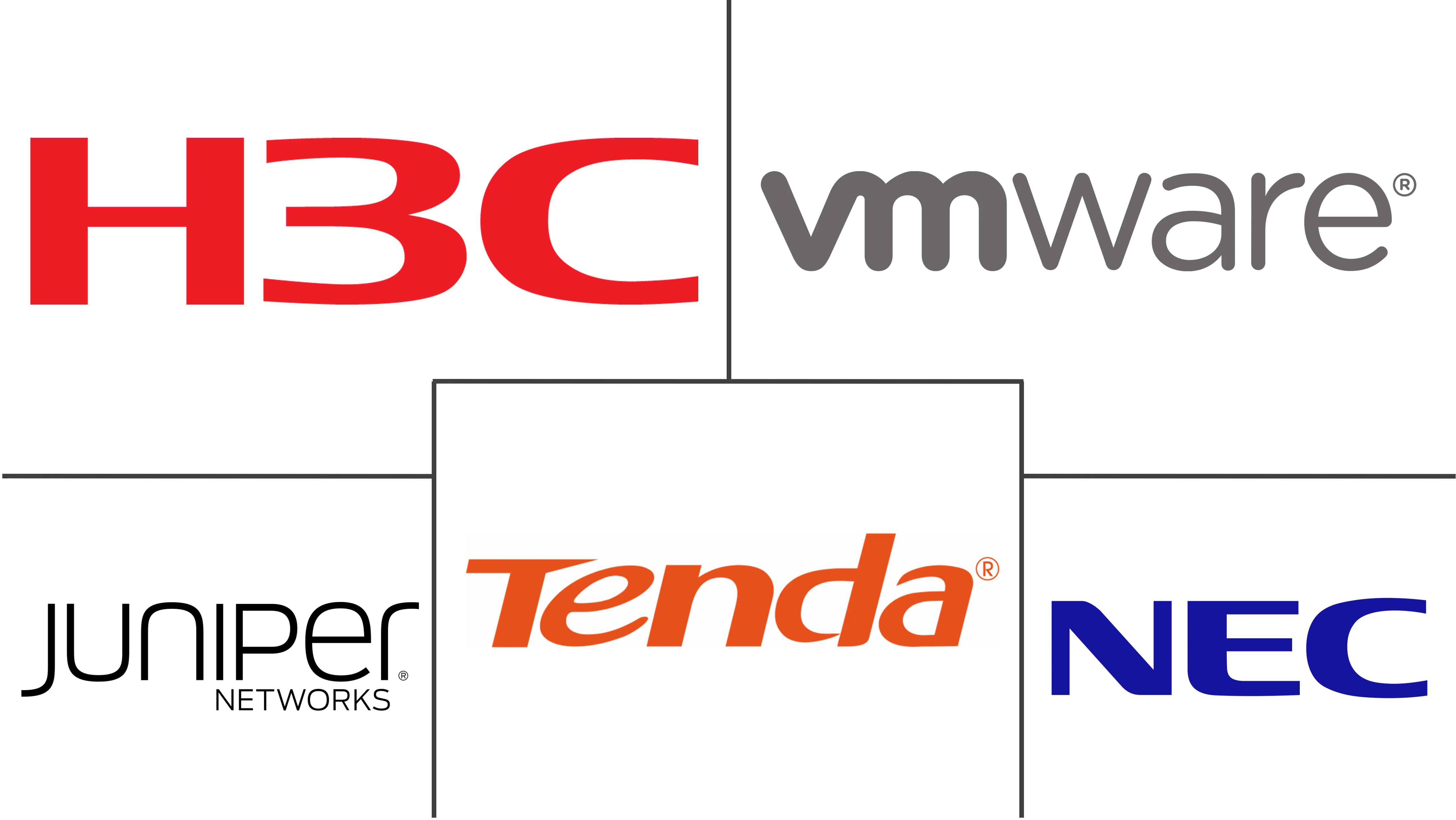APAC Data Center Networking Market Size and Share
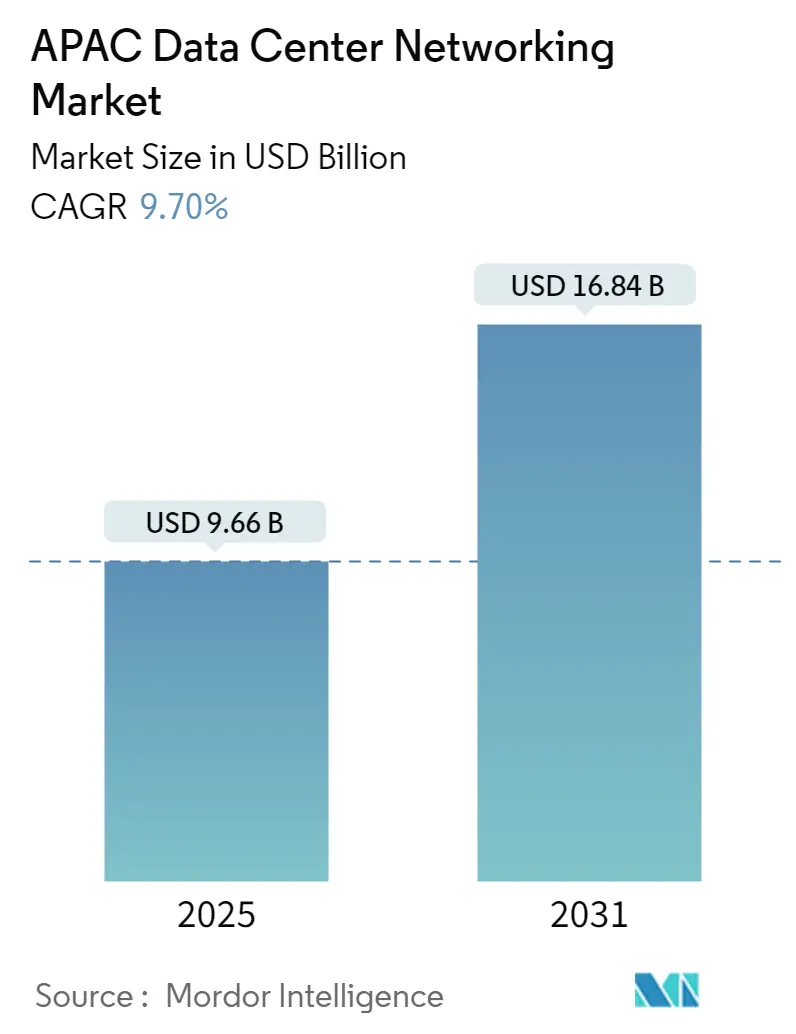
APAC Data Center Networking Market Analysis by Mordor Intelligence
The APAC Data Center Networking Market size is estimated at USD 9.66 billion in 2025, and is expected to reach USD 16.84 billion by 2031, at a CAGR of 9.7% during the forecast period (2025-2031).
Asia Pacific is experiencing strong adoption of visualization tools, specifically standalone visualization. Increasing data traffic along with increasing data center constructions and servers is laying the demand for networking solutions.
- The upcoming IT load capacity of the Asia-Pacific data center construction market is expected to reach 23K MW by 2029. The region's construction of raised floor area is expected to increase 74.5 million sq. ft by 2029.
- The region's total number of racks to be installed is expected to reach 4.2 million units by 2029. India is expected to house the maximum number of racks by 2029.
- There are close to 160 submarine cable systems connecting the Asia-Pacific, and many are under construction. One such submarine cable that is estimated to start service in 2024 is Southeast Asia-Japan Cable 2 (SJC2), which stretches over 10,500 km with a landing point in China, Taiwan, Japan, South Korea, Thailand, and Vietnam.
APAC Data Center Networking Market Trends and Insights
IT and Telecom to Hold Significant Share
- In Asia-Pacific, the hyper-connectivity environment has reinforced the importance of telcos, which play a foundational role in supporting consumers' and enterprises' connectivity and collaboration needs. Across Asia-Pacific, 75% of the operators registered positive revenue growth. South Korea is second only to Hong Kong in the world rankings of telecom market maturity.
- South Korea is also on the leading edge of the latest telecom technology developments, including around 6G. In terms of investment, in November 2022, Malaysian telcos Celcom and DiGi approved the merger agreement. Once the two companies are fully merged, the new entity will be one of the largest carriers in Malaysia, with over 20 million subscribers.
- The advent of 5G in the Asia-Pacific region has accelerated small-cell deployment for high-speed network connectivity. Many nations have created exemption standards that can be applied when deploying new Small Cells. For instance, in Singapore, The Infocomm Media Development Authority (IMDA) has directed the building developers and owners to provide rooftop spaces free of charge for telecommunication equipment the telecom providers.
- Regarding IT infrastructure, the Southeast Asia data center market is expected to shift majorly towards adopting switches with a capacity of over 40GbE and flash storage devices. Data localization law has been a major driver for data center construction in countries where operators must develop facilities to store data and information within their borders. Data localization in Malaysia, Indonesia, and Vietnam has been a boon for the growth of the data centers in such countries, leading to major networking solution adoption.
- In April 2022, Internet Multifeed Co., the provider of JPNAP, one of Asia's most significant Internet exchanges (IX1), Internet Initiative Japan Inc. (IIJ), an internet service provider (ISP) in Japan, and NTT Communications Corporation, the ICT solutions, and international communications business within the NTT Group, announced that they had conducted the first successful IX interconnection in Asia utilizing 400-gigabit Ethernet, which has four times the traffic bandwidth of regularly used 100-gigabit Ethernet. Such initiatives are expected to showcase a positive market demand.
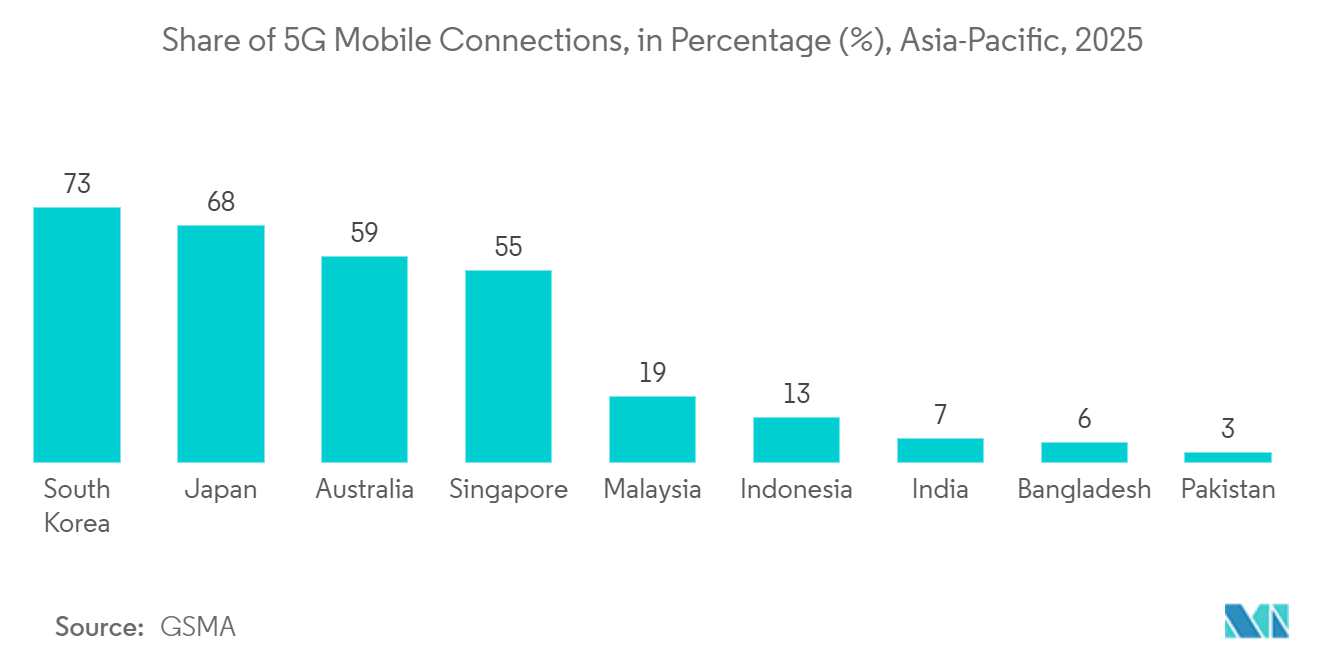
India to Hold Significant Growth
- India is one of the fastest-growing economies globally, and due to the combined impact of the growth of several end-user segments utilizing networking systems, the country is expected to showcase major market growth. The number of active Internet users in India is expected to rise by 45% from 2020 to 2025 and touch 900 million by 2025 from around 622 million in 2020, according to the Internet and Mobile Association of India.
- Further, companies are investing in developing various new technologies and Wi-Fi routers for increased efficiency, network capabilities, and reduced latency. For instance, in September 2022, ASUS launched the ROG Rapture GT-AX6000 Wi-Fi-6 router in India. It is equipped with Broadcom 2.0 GHz quad-core 64-bit CPU and Wi-Fi 6 chipsets. This router is capable of delivering wireless speeds of up to 6000 Mbps and contains two 2.5 Gbps Ethernet ports.
- In terms of policy, the Government of India and various state governments are revising their data center policies to support the infrastructural growth of data centers in India through tax subsidies. Under a national policy framework for data centers, the IT ministry intends to provide up to INR 15,000 crore as incentives. The government plans to invest up to INR 3 lakh crore in the data center ecosystem over the next five years, as per the policy.
- Since the pandemic, cloud computing has evolved as a mission-critical technology for businesses, governments, and consumers. For instance, in May 2024, Bharti Airtel ("Airtel") and Google Cloud announced a long-term partnership aimed at providing cloud solutions to businesses in India. This strategic alliance is set to provide a range of advanced cloud solutions from Google Cloud, accelerating cloud adoption and modernization for Airtel's clientele.
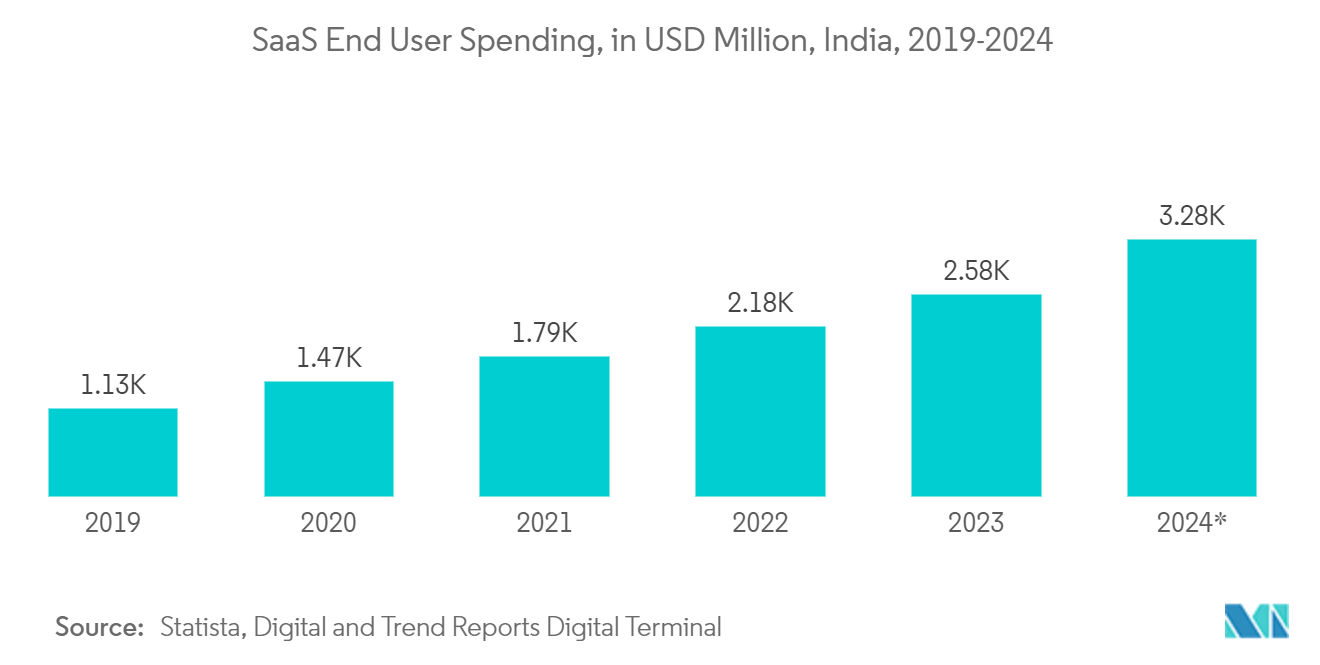
Competitive Landscape
The Asia-Pacific Data Center Networking market is characterized by a significant degree of fragmentation among the key players, who have notably intensified their competitive strategies in recent years. Prominent among these players are Shenzhen Tenda Technology Co., Ltd., H3C Holding Limited, NEC Corporation, and others. These leading companies, wielding substantial market influence, are diligently focused on expanding their customer base throughout the region. To achieve this, they have embraced strategic collaborative initiatives designed to enhance their market share and bolster their profitability.
In November 2022, VMware, Inc. unveiled its cutting-edge SD-WAN solution. This comprehensive offering includes the introduction of a new SD-WAN Client, which is specifically designed to empower enterprises to securely, reliably, and optimally deliver applications, data, and services across any network to any device.
APAC Data Center Networking Industry Leaders
-
Shenzhen Tenda Technology Co.,Ltd.
-
H3C Holding Limited
-
NEC Corporation
-
Juniper Networks Inc.
-
VMware Inc.
- *Disclaimer: Major Players sorted in no particular order
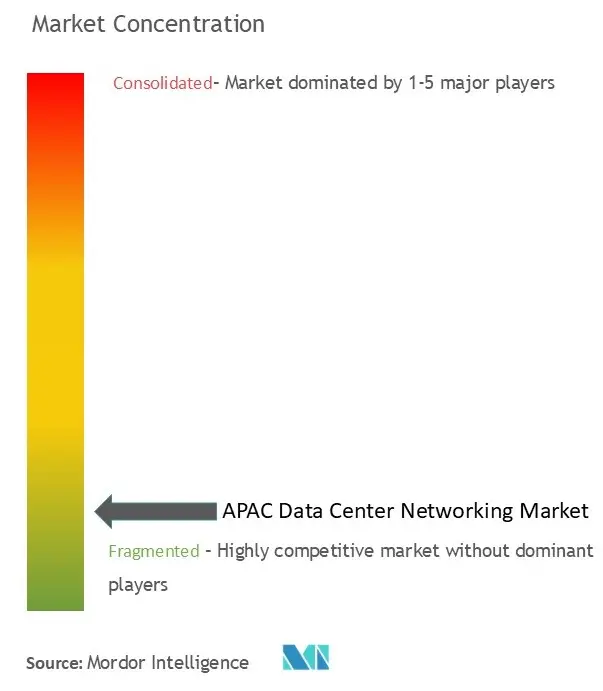
Recent Industry Developments
- July 2023: Moxa Inc. launched its MDS-G4020-L3-4XGS series of Ethernet switches, a versatile line of Layer 3 full Gigabit modular managed switches that support four 10GbE ports and sixteen Gigabit ports, including four embedded ports. Additionally, the series boasts four interface module expansion slots and two power module slots, providing users with the flexibility required for a wide range of applications.
- March 2023: Arista Networks, Inc. introduced the Arista WAN Routing System, which seamlessly integrates three innovative networking solutions: enterprise-class routing platforms, carrier/cloud-neutral internet transit capabilities, and the CloudVision Pathfinder Service. This comprehensive system simplifies and enhances the performance of customer-wide area networks. Leveraging Arista's EOS routing capabilities and CloudVision management, the Arista WAN Routing System offers the architectural framework, features, and platforms necessary for the modernization of federated and software-defined wide-area networks.
APAC Data Center Networking Market Report Scope
Data center networking refers to the set of technologies, protocols, and hardware used to connect physical and network-based devices and manage the network infrastructure, storage, and processing of applications and data. Data center networking is very critical for 100% uptime of data centers. In the current web-connected world, business workloads are executed on single computers, hence leading to the need for data center networking. Networks provide servers, clients, applications, and middleware with a standard plan to stage the execution of workloads and also to manage access to the data produced.
The Asia-Pacific data center networking market is segmented by component type (product (ethernet switches, routers, storage area network (SAN), application delivery controller (ADC), and other networking equipment) and services (installation & integration, training & consulting, and support & maintenance)), end-user (IT & telecommunication, BFSI, government, media & entertainment, and other end-users), and country (India, China, Japan, Indonesia, Thailand, Australia, Singapore, Hong Kong, Taiwan, South Korea, Philippines, Vietnam, Malaysia and the Rest of Asia-Pacific).
The market sizes and forecasts are provided in terms of value (USD) for all the above segments.
| By Product | Ethernet Switches |
| Router | |
| Storage Area Network (SAN) | |
| Application Delivery Controller (ADC) | |
| Other Networking Equipment | |
| By Services | Installation & Integration |
| Training & Consulting | |
| Support & Maintenance |
| IT & Telecommunication |
| BFSI |
| Government |
| Media & Entertainment |
| Other End-Users |
| Indonesia |
| India |
| China |
| Australia |
| South Korea |
| Philippines |
| Thailand |
| Singapore |
| New Zealand |
| Japan |
| Malaysia |
| Vietnam |
| Hong Kong |
| Taiwan |
| By Component | By Product | Ethernet Switches |
| Router | ||
| Storage Area Network (SAN) | ||
| Application Delivery Controller (ADC) | ||
| Other Networking Equipment | ||
| By Services | Installation & Integration | |
| Training & Consulting | ||
| Support & Maintenance | ||
| End-User | IT & Telecommunication | |
| BFSI | ||
| Government | ||
| Media & Entertainment | ||
| Other End-Users | ||
| Country | Indonesia | |
| India | ||
| China | ||
| Australia | ||
| South Korea | ||
| Philippines | ||
| Thailand | ||
| Singapore | ||
| New Zealand | ||
| Japan | ||
| Malaysia | ||
| Vietnam | ||
| Hong Kong | ||
| Taiwan | ||
Key Questions Answered in the Report
How big is the APAC Data Center Networking Market?
The APAC Data Center Networking Market size is expected to reach USD 9.66 billion in 2025 and grow at a CAGR of 9.70% to reach USD 16.84 billion by 2031.
What is the current APAC Data Center Networking Market size?
In 2025, the APAC Data Center Networking Market size is expected to reach USD 9.66 billion.
Who are the key players in APAC Data Center Networking Market?
Shenzhen Tenda Technology Co.,Ltd., H3C Holding Limited, NEC Corporation, Juniper Networks Inc. and VMware Inc. are the major companies operating in the APAC Data Center Networking Market.
What years does this APAC Data Center Networking Market cover, and what was the market size in 2024?
In 2024, the APAC Data Center Networking Market size was estimated at USD 8.72 billion. The report covers the APAC Data Center Networking Market historical market size for years: 2019, 2020, 2021, 2022, 2023 and 2024. The report also forecasts the APAC Data Center Networking Market size for years: 2025, 2026, 2027, 2028, 2029, 2030 and 2031.
Page last updated on:
APAC Data Center Networking Market Report
Statistics for the 2025 APAC Data Center Networking market share, size and revenue growth rate, created by Mordor Intelligence™ Industry Reports. APAC Data Center Networking analysis includes a market forecast outlook for 2025 to 2031 and historical overview. Get a sample of this industry analysis as a free report PDF download.
